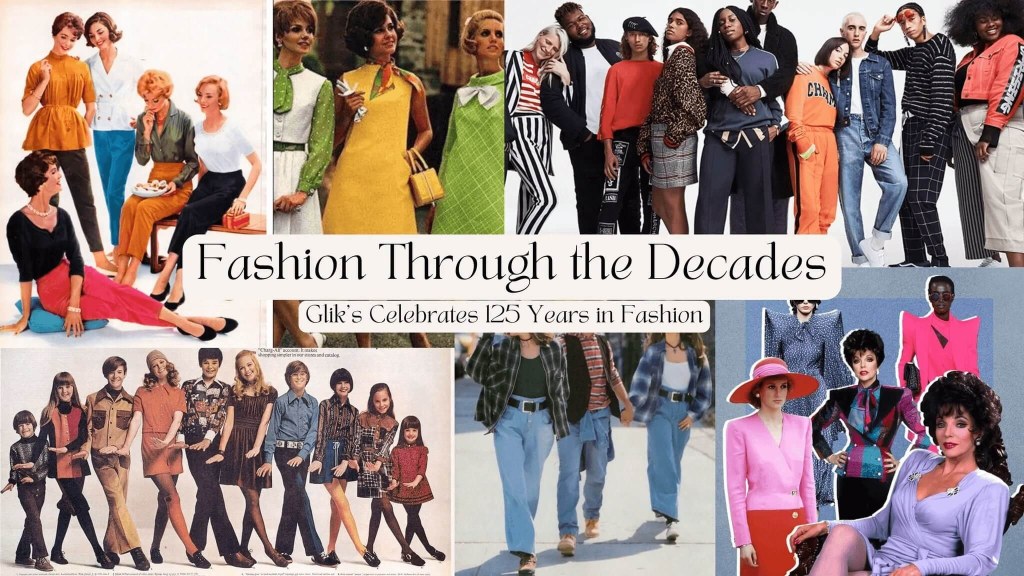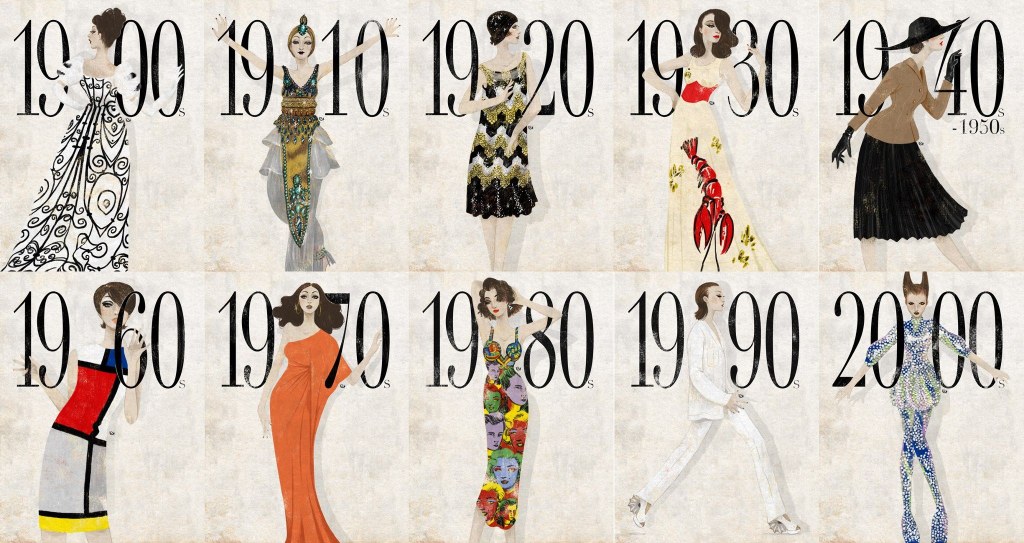Fashion Trends Every Decade
Greetings, Readers!
Welcome to our article on fashion trends every decade. Fashion trends have a significant impact on our lives, reflecting the cultural, social, and economic changes of each era. In this article, we will take you on a journey through time, exploring the fashion trends that defined each decade. Join us as we delve into the fascinating world of fashion history!
The Roaring Twenties: Flapper Style Takes Center Stage
👗 The 1920s saw the rise of the flapper style, characterized by short, loose-fitting dresses, dropped waistlines, and low waistlines.

Image Source: shopify.com
📅 This trend emerged after World War I and represented the newfound freedom and liberation of women.
🌍 The flapper style originated in the United States but quickly spread across Europe.
❓ Why did the flapper style become so popular? It was a rebellion against traditional Victorian fashion norms, signifying women’s desire for independence and social equality.

Image Source: insider.com
💼 However, this trend also faced criticism for being too scandalous and challenging societal norms.
👍 The flapper style empowered women to express themselves and paved the way for more progressive fashion movements in the future.
The Fabulous Fifties: Embracing Elegance and Glamour

Image Source: pinimg.com
👗 The 1950s marked a return to femininity, with hourglass silhouettes, tailored dresses, and full skirts.
📅 This era coincided with the post-World War II economic boom, allowing people to indulge in fashion and luxury.
🌍 The epitome of 1950s fashion was seen in Hollywood, with glamorous stars like Audrey Hepburn and Marilyn Monroe setting the trends.
❓ Who popularized the iconic 1950s fashion? Designers such as Christian Dior, Coco Chanel, and Hubert de Givenchy played a pivotal role in shaping the fashion of this era.
💼 The 1950s fashion embraced traditional gender roles, with women expected to embody grace and elegance.
👍 Despite its limitations, the fashion of the 1950s is still celebrated for its timeless elegance and classic designs.
The Swinging Sixties: A Revolution in Fashion
👗 The 1960s witnessed a radical departure from the previous decades, with the emergence of the mod fashion movement.
📅 This era was defined by bold colors, mini skirts, and the iconic shift dress.
🌍 The mod fashion movement originated in the United Kingdom and quickly gained popularity worldwide, especially in London.
❓ When did the mod fashion movement reach its peak? The mid-1960s saw the mod style reach its zenith, with icons like Twiggy and Jean Shrimpton leading the way.
💼 The mod fashion movement challenged traditional beauty standards and embraced a more youthful and rebellious aesthetic.
👍 The mod fashion movement of the 1960s revolutionized the industry and paved the way for future fashion subcultures.
The Disco Era: Glitz, Glam, and Platform Shoes
👗 The 1970s was all about disco fever, with flashy and glamorous fashion taking center stage.
📅 This era was influenced by the rise of disco music and the popularity of nightclubs.
🌍 Disco fashion was prominent in cities like New York, London, and Paris.
❓ Where did the disco fashion trend originate? It was heavily influenced by the African American and LGBTQ+ communities.
💼 Disco fashion was criticized for being excessive and lacking substance.
👍 Despite the criticism, the disco era left an indelible mark on fashion history, with elements like platform shoes still being celebrated today.
The Bold Eighties: Excess and Individuality
👗 The 1980s fashion was characterized by its bold and extravagant nature, reflecting the cultural and economic prosperity of the era.
📅 This decade marked the rise of power dressing, with padded shoulders, oversized blazers, and bold colors dominating the fashion scene.
🌍 The fashion capitals of the world, such as New York, Milan, and Paris, were at the forefront of the 1980s fashion trends.
❓ Why did power dressing become so popular in the 1980s? It was a response to the increasing number of women entering the workforce and seeking equality in traditionally male-dominated industries.
💼 The excessive nature of 1980s fashion has been criticized for promoting materialism and superficiality.
👍 Despite the criticism, 1980s fashion allowed individuals to express their individuality and embrace self-confidence.
The Minimalistic Nineties: Grunge and Casual Chic
👗 The 1990s fashion was characterized by a more relaxed and minimalistic approach, in stark contrast to the excess of the previous decade.
📅 This era saw the rise of grunge fashion, with flannel shirts, ripped jeans, and combat boots becoming iconic symbols of the time.
🌍 The grunge fashion movement originated in Seattle, United States, and gained popularity throughout the world, particularly among the youth.
❓ How did grunge fashion influence the 1990s? It challenged the notion of traditional beauty and embraced a more alternative and rebellious aesthetic.
💼 Grunge fashion was criticized for being unkempt and lacking sophistication.
👍 The 1990s fashion embraced a more casual and comfortable approach, setting the foundation for the athleisure trend that continues to dominate today.
The Modern Era: A Blend of Past and Present
👗 Fashion trends in the modern era are heavily influenced by nostalgia and a fusion of styles from different decades.
📅 Today, fashion trends change rapidly due to the rise of social media and fast fashion.
🌍 Fashion capitals around the world, such as New York, London, Milan, and Paris, continue to play a significant role in setting trends.
❓ How does technology impact modern fashion trends? Social media platforms like Instagram and TikTok have democratized fashion, allowing anyone to be an influencer and shape trends.
💼 The fast fashion industry has faced criticism for its negative environmental and social impact.
👍 Despite its challenges, the modern era allows for individual expression and the freedom to experiment with different styles.
Advantages and Disadvantages of Fashion Trends Every Decade
Every fashion trend comes with its advantages and disadvantages. Let’s explore some of them:
Advantages:
1. Self-expression: Fashion trends allow individuals to express their personality, creativity, and individuality.
2. Cultural reflection: Fashion trends reflect the cultural, social, and economic changes of each era, providing valuable insights into history.
3. Confidence boost: Wearing fashionable clothing can boost one’s self-confidence and improve overall well-being.
4. Empowerment: Certain fashion movements, such as the flapper style and power dressing, have empowered individuals and challenged societal norms.
5. Economic growth: The fashion industry plays a significant role in stimulating economic growth and creating job opportunities.
Disadvantages:
1. Pressure to conform: Fashion trends can create pressure to conform to certain beauty standards and societal norms.
2. Environmental impact: The fast fashion industry has a detrimental impact on the environment, contributing to pollution and waste.
3. Expensive: Keeping up with fashion trends can be costly, placing a financial burden on individuals.
4. Lack of sustainability: The fashion industry’s focus on fast fashion often leads to poor working conditions and exploitation of labor.
5. Limited inclusivity: Fashion trends have historically favored certain body types and excluded marginalized communities. Efforts for inclusivity are still ongoing.
Frequently Asked Questions (FAQ)
1. Are fashion trends cyclical?
Yes, fashion trends often cycle back in popularity. What was once popular in the past can resurface as a trend in the present.
2. Can fashion trends influence other industries?
Absolutely! Fashion trends have a ripple effect and can influence industries such as beauty, home decor, and entertainment.
3. How can I stay updated on the latest fashion trends?
Follow fashion influencers, read fashion magazines, and engage with fashion communities on social media to stay updated on the latest trends.
4. Are fashion trends important?
Fashion trends are important in reflecting social and cultural changes, providing a means of self-expression, and driving economic growth.
5. Can fashion trends be sustainable?
Efforts are being made to make fashion more sustainable, such as promoting ethical production practices and embracing slow fashion.
Conclusion
In conclusion, fashion trends every decade have played a significant role in shaping our cultural, social, and economic landscape. From the rebellious flapper style of the 1920s to the casual chic of the 1990s, each era has left its mark on fashion history. While fashion trends have their advantages and disadvantages, they continue to evolve and inspire us. So, embrace your personal style, stay true to yourself, and let fashion be a form of self-expression. Stay fashionable!
Thank you for joining us on this journey through fashion history. We hope you found this article informative and inspiring. Now go out there and make a fashion statement!
Final Remarks
Disclaimer: The views and opinions expressed in this article are solely those of the author and do not necessarily reflect the official policy or position of any fashion brands, organizations, or institutions mentioned. The information provided is for general informational purposes only and should not be relied upon as professional advice. We recommend consulting with a fashion expert or stylist for personalized fashion guidance.